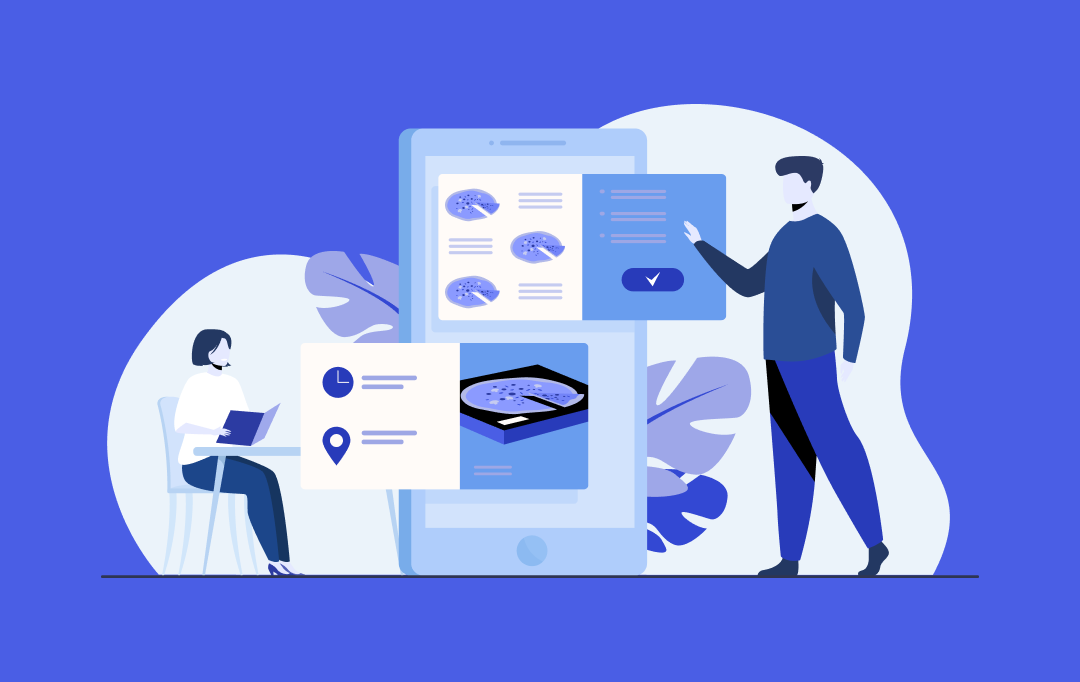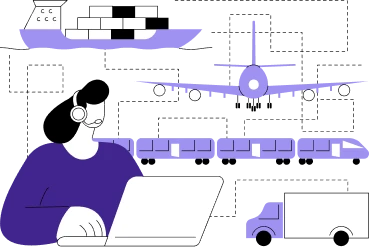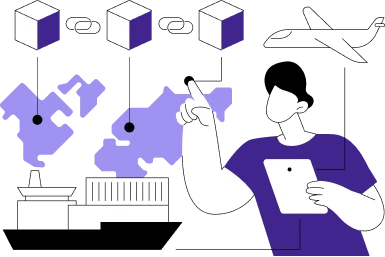- The Market Shift: How AI Is Driving Growth in Transportation Software
- The Business Benefits of AI-Powered Transportation Software Development
- 1. Safer and More Reliable Operations
- 2. Greater Efficiency and Lower Operating Costs
- 3. Demand Forecasting and Dynamic Scheduling
- 4. Smarter Traffic and Route Planning
- 5. Improved Passenger and Driver Experience
- 6. Cleaner and More Sustainable Mobility
- 7. Better Decisions Through Data
- Top 10 Use Cases of AI in Transportation
- 1. Predictive Maintenance
- 2. Route Optimization
- 3. Traffic Management and Control
- 4. Autonomous Vehicles
- 5. Fleet Management
- 6. Passenger Experience Personalization
- 7. Driver Behavior Analytics
- 8. Smart Parking Systems
- 9. Inventory and Supply Chain Optimization
- 10. Flight Delay Prediction and Management
- How to Build AI-Based Transportation Software Step by Step
- Define Goals And KPIs
- Identify High-Impact Use Cases And Prioritize
- Build An MVP Roadmap And Define Success Early
- Create An Integration Blueprint For Legacy Systems And APIs
- Set Up Infrastructure And Plan For Scalability
- Test, Simulate, And Run Pilot Programs
- Deploy And Transition To Full Operations
- Challenges in AI-Based Transportation Software Development
- How to Measure ROI and Long-Term Value from AI in Transportation
- Operational ROI
- Customer Experience ROI
- Safety and Compliance ROI
- Strategic ROI and Long-Term Value
- Future Trends in AI Transportation Software Development
- Autonomous and Connected Mobility
- Sustainability and Green Transport
- Generative AI and Predictive Simulation
- 5G, Edge AI, and Smart Cities
- Build Your AI-Based Transportation Software with Appinventiv
- FAQs
Key takeaways:
- AI-based transportation software helps reduce fuel use and delays through real-time route optimization.
- Predictive maintenance powered by AI lowers downtime and boosts vehicle lifespan.
- Integrating AI with legacy systems improves efficiency without disrupting daily operations.
- Cloud and IoT-backed AI infrastructure supports scalability and real-time analytics.
- Companies see faster ROI with MVP-driven AI software rollouts.
- Future-ready AI transport systems will center on autonomy, green mobility, and smart city integration.
Every transport executive knows the same headache: your systems are full of data, yet your network still runs on guesswork. Schedules slip, fleet downtime spikes without warning, and customer experience depends more on luck than planning. For C-suite executives and operations heads, this is more than inefficiency but a margin erosion hiding in plain sight.
AI in transportation software development changes that equation. When applied right, it turns the daily chaos of logistics into measurable control, predicting failures before they happen, optimizing fuel use, routing in real time, and keeping passengers or shipments on schedule. It’s not about adding another dashboard; it’s about building transportation software that thinks, learns, and adapts faster than your teams can react.
What makes this shift so critical now? Because the economics have caught up. Cloud maturity, sensor data, and scalable AI frameworks have made AI-powered transportation software development both achievable and profitable. Companies are using it to shrink delivery times, lower fuel costs, and cut operational risks, all while delivering safer, smarter mobility experiences.
From predictive maintenance and route optimization to understanding how AI enables self-driving technology, the multiple applications of AI in transportation justify why the industry is witnessing an exponential surge.
This blog is your field guide to that transformation.
By the end, you’ll see why investing in AI-based transportation solutions isn’t a technology experiment but a business strategy for sharper forecasting, safer operations, and sustainable growth.
AI is set to automate over $65 billion worth of work in transportation and the next big movers are already using it to outpace the competition. The real question is, will you be one of them?
The Market Shift: How AI Is Driving Growth in Transportation Software
Transportation today looks nothing like it did even a few years ago. The focus has moved from engines and hardware to data, connectivity, and automation. What used to be a business of vehicles and routes is now becoming a business of intelligence and prediction. For leaders running logistics, mobility, or infrastructure networks, the use of AI in the transportation industry has changed what success means – speed, safety, and sustainability now sit at the center of every board discussion.
According to IDC, transportation leaders and public agencies around the world are rebuilding how mobility works. The next generation of transport systems is being designed to use AI, IoT, automation, and edge computing to improve passenger safety, energy efficiency, and overall reliability. In simple terms, it’s not only about building roads or fleets anymore but about building digital platforms that can sense, decide, and act in real time.
The numbers show how big this change could be. MIT estimates that artificial intelligence could help automate or support $65 billion worth of tasks in transportation. These include maintenance scheduling, dispatch planning, and fleet monitoring- areas that have long relied on manual oversight. When AI steps in, those same processes can run faster, cheaper, and with fewer errors.
Insights from McKinsey’s mobility research show the same direction. Venture investor Laurie Yoler, who has worked with Tesla and Zoox, shared that autonomous technologies have already moved from “science fiction to scalable business reality.” Yet she also noted that regulation and public trust will decide which companies actually benefit. That means leadership needs to balance innovation with governance, making sure technology creates confidence, not just capability.
Spending data supports that shift in mindset. PwC found that 63% of top-performing companies are expanding cloud budgets to support AI and generative AI adoption, while 34% say sustainability goals are driving those investments. For transportation businesses, this means AI-based transportation software development is being used to do more than just cut costs – it’s helping fleets reduce emissions, improve energy use, and meet stricter environmental goals. PwC calls this “value over volume” – using AI where it drives measurable impact, not just where it’s possible to use it.
Generative AI is also beginning to play a stronger role. McKinsey highlights that these tools can connect huge amounts of scattered data, from traffic sensors to customer feedback, producing insights and improving planning. But the firm also stresses that technology alone doesn’t guarantee success. Companies need new ways of working, better data discipline, and leaders who can guide teams through this change.
On a broader scale, PwC also adds that AI will also help drive the energy transition, making it easier for transport companies to manage costs while staying sustainable. Combined with lifestyle changes – fewer young people driving, more demand for shared and electric mobility, the industry is clearly reinventing itself.
For business leaders, the message is simple:
AI in transportation software development is no longer an experiment; it’s the foundation of the next phase of mobility. The companies that treat it as a core strategy that is built into operations, safety, and sustainability will be the ones leading the market in the years ahead.
The Business Benefits of AI-Powered Transportation Software Development
If you manage fleets or move people for a living, you already know how unpredictable every day can be. One bad route, one delay, and the whole schedule feels off. This is precisely where AI consulting services are making a tangible impact. They empower transport companies to leverage artificial intelligence to plan better, react faster, and run cleaner. The transformation doesn’t happen through fancy dashboards, but by applying expert analysis to the data that’s already there – the fuel logs, sensors, maps, and traffic feeds that most teams barely look at. Let’s look into the benefits of AI in transportation software in detail below.
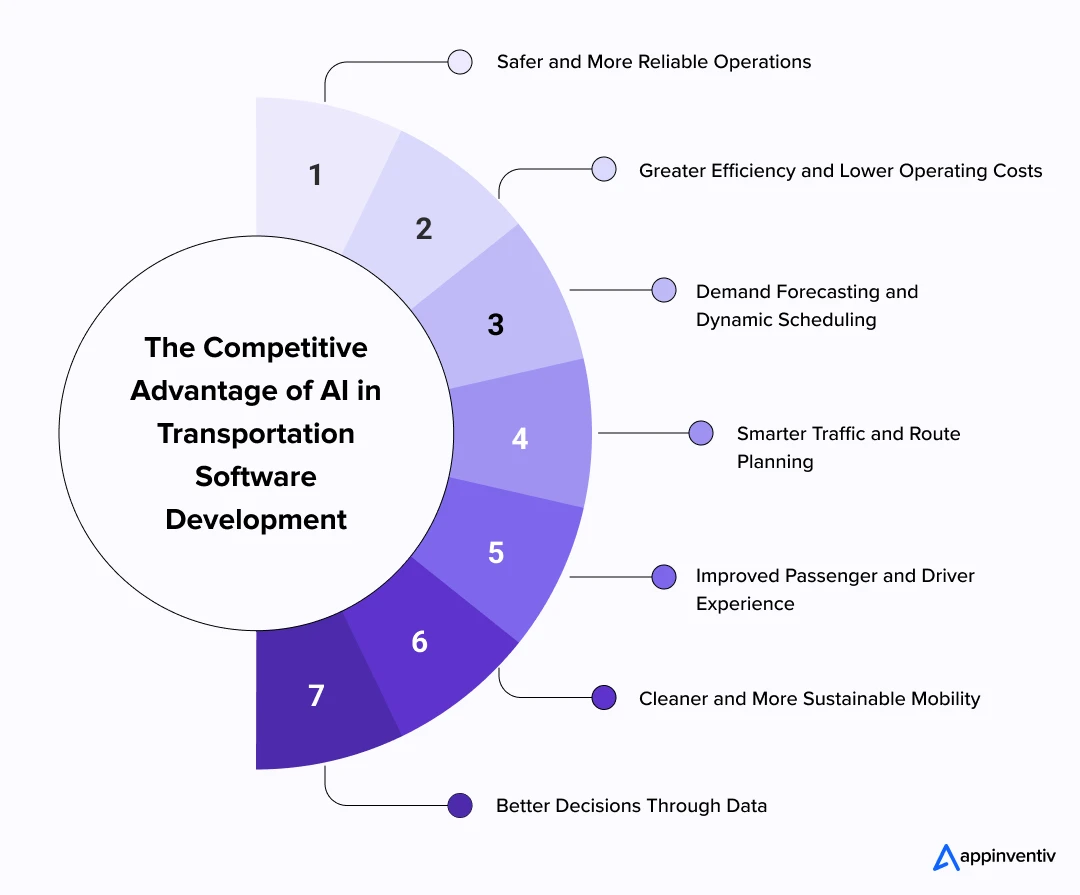
1. Safer and More Reliable Operations
Accidents usually come down to small warnings people miss. AI doesn’t. It keeps an eye on tire pressure, speed, driver alertness, and road conditions all at once. If something looks wrong, it can flag it instantly. A lot of companies now use it to reduce human error and to spot problems before they turn into costly breakdowns. The result is simple – fewer accidents, better uptime, and a safer experience for everyone involved.
2. Greater Efficiency and Lower Operating Costs
Ask any fleet manager and they’ll tell you that fuel and time are what really eat into profit. AI helps cut both. It studies traffic, weather, and delivery data to plan smarter routes. It can even change plans mid-journey when a new obstacle appears. Over time, those small adjustments save real money and take the pressure off dispatch teams who used to handle it manually.
[Also Read: How Much Does it Cost to Develop a Fleet Management Software?]
3. Demand Forecasting and Dynamic Scheduling
Transport demand shifts constantly and even public events can throw off entire schedules. With AI-powered transportation management systems, companies can predict these fluctuations early and adjust operations before disruptions occur. AI analyzes past trip data, booking trends, and external factors to forecast demand accurately. This allows managers to plan routes, allocate vehicles, and deploy staff more efficiently, cutting costs and improving customer satisfaction..
4. Smarter Traffic and Route Planning
Nobody enjoys being stuck in traffic. For drivers, it means frustration; for companies, it means money lost. AI systems can look at live city data and adjust traffic lights or suggest alternate paths automatically. Buses and trucks move faster, commuters spend less time waiting, and cities can keep traffic flow steady instead of reactive.
5. Improved Passenger and Driver Experience
AI chatbots in transportation are transforming how passengers interact with service providers. They can check routes, track delays, or get updates instantly instead of waiting in line. Drivers also benefit, receiving guidance that adapts to their driving patterns, helping reduce fatigue and stress.
6. Cleaner and More Sustainable Mobility
As sustainability becomes a serious business goal, AI plays its part there too. It optimizes driving patterns, manages EV charging cycles, and plans routes that use less fuel. When trucks idle less and buses avoid congestion, emissions go down automatically. It’s a small but real step toward greener cities and lower operating costs at the same time.
7. Better Decisions Through Data
Transport generates more data than almost any other sector and most of it goes unused. AI turns that into practical insights. By using AI in the transportation industry, managers can finally see which routes are profitable, which vehicles need attention, or where delays keep happening. Decisions that once depended on gut feeling now rest on clear patterns that anyone can check.
AI in transportation is not a headline trend anymore; it’s becoming everyday infrastructure. Companies that treat it as a core capability and not a side project will find they move faster, spend less, and stay ahead in an industry that never really stops moving.
Top 10 Use Cases of AI in Transportation
Spend a day running deliveries or managing a city route network, and you’ll see how quickly things go sideways. One small delay, a wrong turn, a part that fails mid-route – it adds up fast. That’s where artificial intelligence has started to pull real weight.
It helps people catch problems early, spot better paths, and make sense of all the noise that transport data creates. AI in transportation software development isn’t about fancy automation; it’s about keeping things moving when the old systems start to choke. Let’s look into the AI applications in transportation sector in detail below:
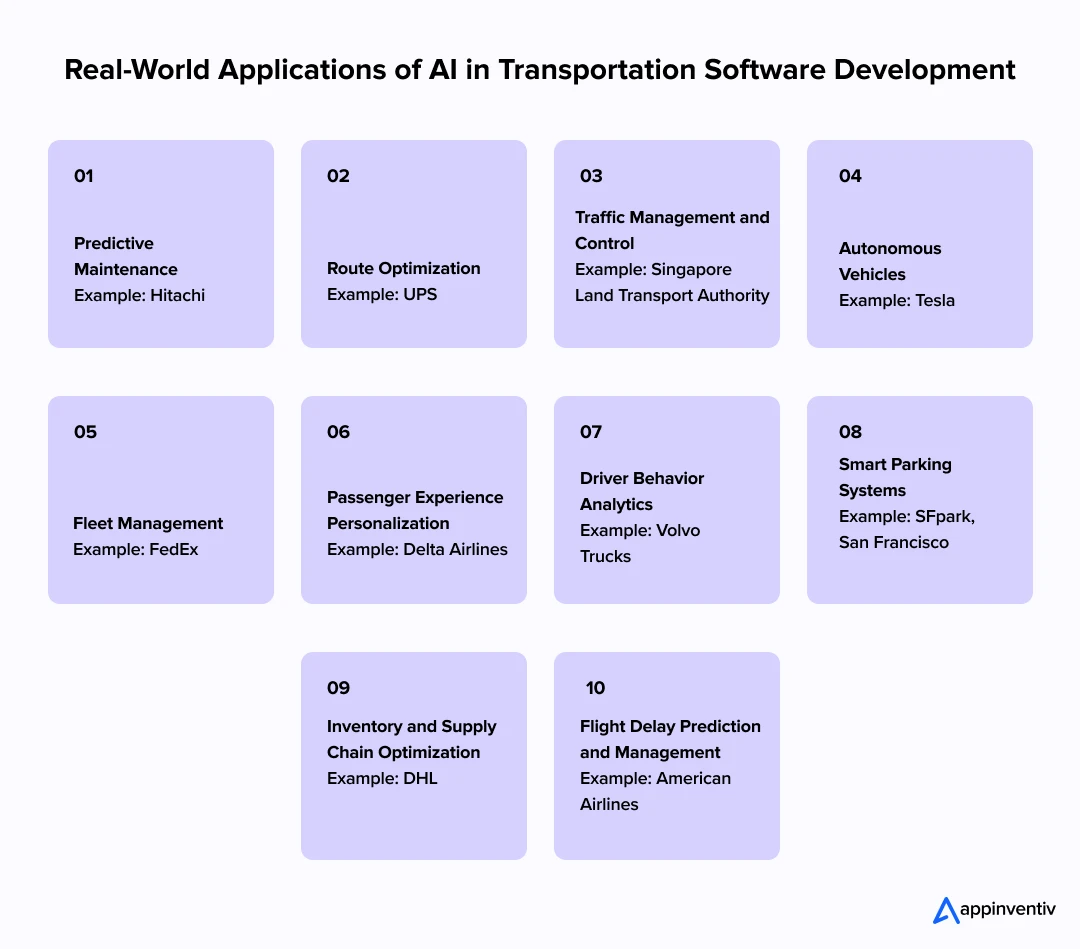
1. Predictive Maintenance
Nothing burns a schedule faster than a breakdown that comes out of nowhere. AI integration into transportation software now helps the riders to understand the heartbeat of every vehicle, such as the sensor data, engine heat, vibration patterns, and quietly warns teams when something’s about to give. Maintenance crews can plan ahead instead of reacting in panic. It doesn’t just save cost; it saves the whole chain from coming to a stop.
Example: At Hitachi, predictive maintenance powered by AI has become routine. Their train systems pick up early faults from data that humans wouldn’t even notice, and maintenance gets done before commuters ever feel a delay.
2. Route Optimization
Drivers know that the “shortest” route isn’t always the fastest. AI looks at traffic, weather, and even driver history to build smarter routes that shift in real time. Over a week, that might mean a few minutes saved each trip; over a year, it’s thousands of gallons of fuel and fewer missed deadlines.
[Also Read: Route Planner App Development – Costs, Benefits, Features]
Example: UPS is one of the AI in transportation software examples that has made its mark. Their AI software for transportation route optimization trims miles, skips unnecessary turns, and saves millions in fuel costs every year. The logic is simple; small changes multiplied over thousands of vehicles equal massive results.
3. Traffic Management and Control
City roads are unpredictable, but AI gives planners a fighting chance. By watching feeds from cameras and sensors, it can predict where congestion will build and adjust lights before it starts. The city moves a little smoother, emissions drop a little lower, and the morning rush feels less like a battle.
Example: Singapore’s Land Transport Authority has leaned heavily on AI-based control. The traffic signals talk to each other now, adapting on the fly, which has noticeably shortened travel times for daily commuters.
4. Autonomous Vehicles
Self-driving cars get all the headlines, but what’s really interesting is how much AI they rely on every second. The system sees the world through dozens of sensors, decides what each movement means, and reacts faster than a person could. It’s a mix of vision, prediction, and a bit of courage from the engineers who trust it.
Example: Tesla feeds data from millions of miles into its AI learning model. Every new drive teaches the system how to handle rain, turns, or traffic it’s never seen before. The more it learns, the safer the fleet becomes.
[Also Read: Everything You Need to Know About Tesla Supercharger Development Cost]

5. Fleet Management
Managing fleets used to mean phone calls, whiteboards, and crossed fingers. Now, AI quietly watches every vehicle in real time, for example- who’s on the road, who’s idle, who’s late. It spots inefficiencies, predicts fuel needs, and even schedules downtime automatically. It doesn’t replace dispatchers; it just makes their lives a lot easier.
Example: FedEx has built AI into almost every part of its network. The data shows where trucks lose time and how to fix it. What used to be guesswork is now an exact science, but it still feels like common sense when you see it work.
6. Passenger Experience Personalization
Passengers want clarity, no surprises, no endless waiting. AI helps companies give that. It remembers routes, booking habits, and preferences, then adjusts what it shows people next time. Alerts feel personal, not generic, and support feels human even when it’s automated.
Example: Delta Airlines uses AI tools that send travel updates before passengers even think to check. If a gate changes, the system nudges the user instantly. It’s the kind of quiet help people remember later.
7. Driver Behavior Analytics
A lot of accidents start with small habits. For instance, a bit too much speed here or a late brake there. AI watches those patterns without judgment. It helps drivers correct themselves, tracks fatigue, and builds safety into everyday driving. Insurance teams love it, but so do the drivers who get feedback that actually helps.
Example: Volvo Trucks uses onboard AI to monitor how drivers respond on long routes. When someone shows signs of drowsiness, the truck gives a subtle alert that prevents something far worse.
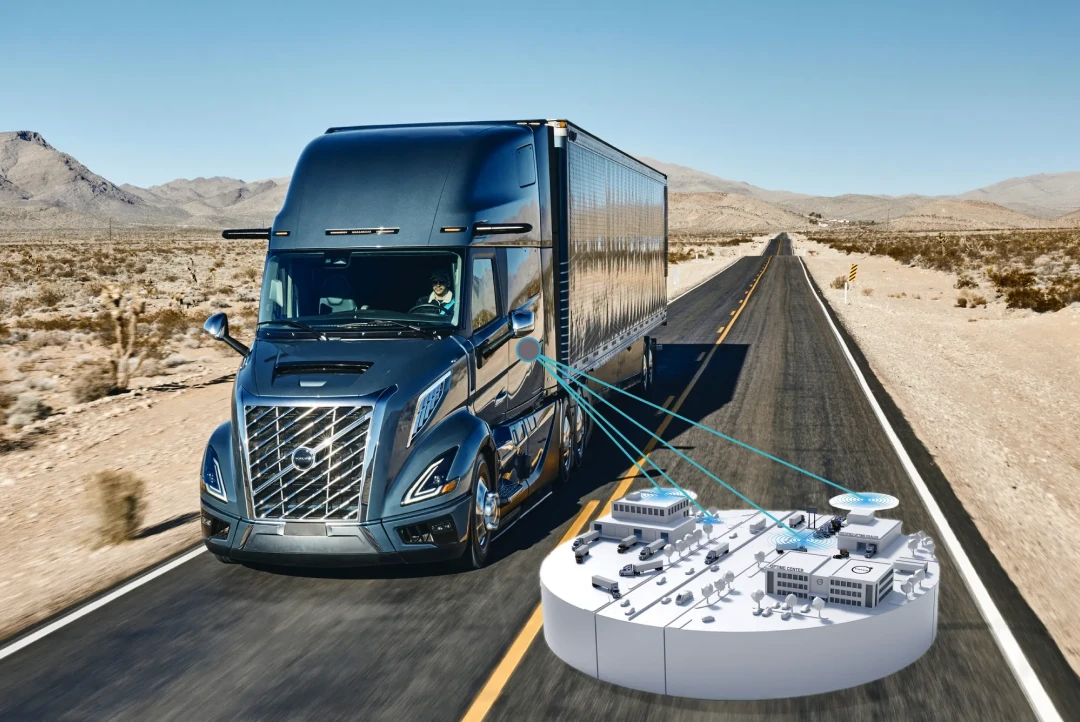
8. Smart Parking Systems
Finding parking shouldn’t feel like hunting treasure, but in most cities, it still does. AI-powered transportation software development paves the way for development of a product that helps in checking occupancy sensors and cameras, showing drivers exactly where space is free. It saves fuel, frustration, and time that would’ve been wasted circling the same block.
Example: SFpark in San Francisco runs on AI-backed sensors that report open spots to a public app. It’s reduced parking search time by about a third which is a small change but a big difference in traffic flow.
9. Inventory and Supply Chain Optimization
Behind every trip is a mountain of stock, orders, and schedules. AI ties those together so nothing falls through the cracks. It predicts demand, avoids overstocking, and spots weak points in the chain before they cause a delay. The biggest shift isn’t speed but reliability.
Example: DHL blends AI with robotics in its warehouses. The system predicts order surges and rearranges storage automatically. Fewer errors, faster turnaround, and less chaos when demand spikes.
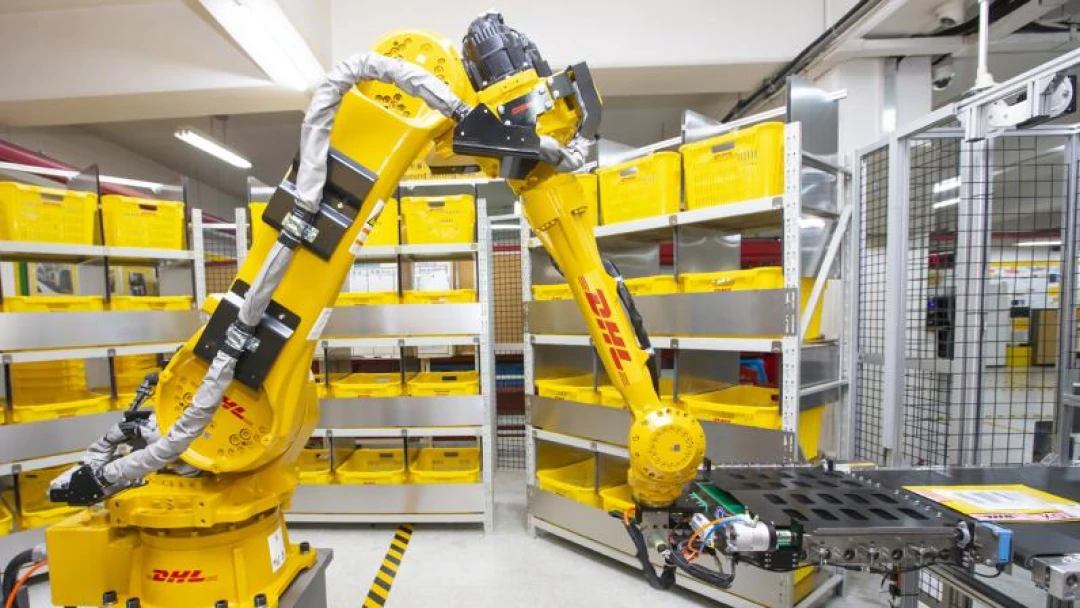
10. Flight Delay Prediction and Management
Airlines have more data than almost any industry, yet flights still run late. AI connects all that information and spots trouble before it hits the schedule. The payoff is better planning and fewer long lines at airports.
Example: American Airlines uses AI-driven prediction to adjust gates and crew shifts before delays spiral. The change feels small to travelers, but it’s huge behind the scenes, leading to smoother operations and calmer airports.
Appinventiv’s Insight
What we see across global transport and logistics enterprises is that AI-driven transportation and logistics software development has moved far beyond experimentation. The companies getting real results are the ones connecting AI use cases like route optimization, predictive maintenance, and driver analytics into a single, intelligent ecosystem. Instead of running isolated pilots, they’re treating AI as part of everyday operations, where every route, delivery, and data point feeds the next improvement. That’s how AI turns from a tool into a competitive edge.
How to Build AI-Based Transportation Software Step by Step
Building AI-based transportation software isn’t a quick sprint. It’s a grind that needs planning, clean data, and a bit of patience. You’re not just coding an app; you’re creating a system that learns from every trip your vehicles take.
That’s why most companies team up with an experienced AI transportation software development partner. They’ve already seen what slows projects down- half-structured data, legacy platforms that barely talk to each other, and APIs that crash right when you need them. Let’s look into the detailed process of integrating AI in transportation software development.
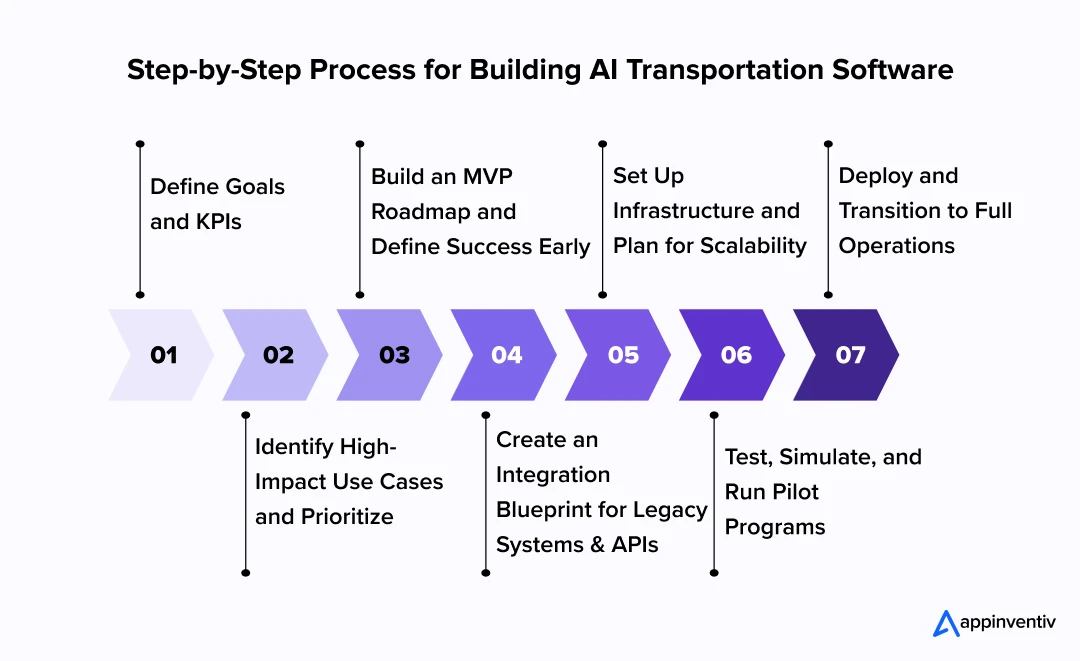
Define Goals And KPIs
You start by asking one simple question: what’s the point? Maybe you want to predict breakdowns, reduce idle hours, or cut delivery time. Keep it specific. A vague goal like “improve performance” won’t get you far. Instead, write “cut downtime by 20%” or “reduce missed deliveries by 15%.” That becomes your anchor when things get messy later.
Identify High-Impact Use Cases And Prioritize
AI integration into transportation software can do plenty, but not everything matters at once. Focus on areas that move the needle early- predictive maintenance, fuel optimization, driver performance. Once those show results, take on bigger things like dynamic routing or real-time demand forecasting. A development partner familiar with transport data will help you spot which one gives you the fastest ROI without wasting effort.
Build An MVP Roadmap And Define Success Early
Don’t try to build the full system straight away. That’s where most teams trip up. Start with an MVP, a small working version that focuses on one issue, maybe fleet monitoring or route planning. Set a target like “cut fuel waste by 10% in 90 days.” If the MVP hits that, you scale. If not, fix it and try again. That’s how AI transportation software development really happens- tight loops, small wins, continuous tweaks.
Create An Integration Blueprint For Legacy Systems And APIs
You can’t throw away the systems you already use. Most transport firms run on Excel sheets, GPS trackers, and old dispatch tools that were never meant to talk to each other. So, plan the integration early. Figure out how AI tools will connect with your existing setup through APIs or middleware. That way, you don’t disrupt the daily work your team depends on. A good AI software partner knows how to blend old and new without breaking what’s already working.
Set Up Infrastructure And Plan For Scalability
Think ahead. Today you’re running one fleet. Tomorrow it could be ten. Choose your base carefully, be it cloud, on-premise, or hybrid. What matters is that the system can handle real-time analytics, IoT sensor data, and constant updates without slowing down. Plan your storage and computing with the future in mind. That saves you from paying double later to fix poor architecture.
Test, Simulate, And Run Pilot Programs
Before rolling it out, break it on purpose. Test every corner. Run simulations for rush hours, bad weather, and system overloads. Then pick one city or one fleet to pilot. Ask drivers and dispatchers what worked and what didn’t. Their feedback is worth more than ten dashboards. Use it to fix gaps, tune algorithms, and make the interface smoother before scaling up.
Deploy And Transition To Full Operations
When the pilot holds steady, expand bit by bit. Watch the data uptime, route accuracy, fuel savings. Keep your internal team close to the process so they learn how to run it themselves. An enterprise AI transportation software development company stays with you through this phase too, training your people, fine-tuning the model, and adding upgrades over time. That’s how an AI project moves from theory to something that actually runs your business better.
Now that you have a clear idea on the steps that are to be carried out during the AI-powered transportation software development process, let us move ahead and understand the challenges that your business can comprehend by simply partnering with a dedicated AI development services provider like Appinventiv.
We can help you design and build data-driven systems that make fleets faster, operations leaner, and decisions smarter.
Challenges in AI-Based Transportation Software Development
Custom AI transportation software development sounds exciting on paper, but the real world is messier. Data comes in scattered formats, legacy systems resist integration, and regulations keep changing faster than software can adapt. For most transport companies, these challenges of AI in transportation software development make the implementation journey longer and more complicated.
Understanding them early helps in planning the right strategy, setting realistic timelines, and avoiding costly mistakes. Below is a closer look at the major challenges in AI-based transportation software development, how they impact operations, and what can be done to manage them effectively.
| Challenge | How It Affects Transportation Operations | Practical Solution |
|---|---|---|
| Data Collection and Quality Issues | AI models rely heavily on clean, structured data. In transportation, data often comes from sensors, GPS, and manual entries, all with different formats and accuracy levels. Poor-quality data leads to bad predictions and unreliable insights. | Build strong data pipelines that clean, validate, and standardize inputs before model training. Use IoT sensors and telematics to collect consistent real-time data. A development partner can also help set up automated quality checks. |
| Integration with Legacy Systems | Many fleets still run on outdated dispatch tools and local databases that don’t connect easily with modern AI platforms. This creates information silos and slows down innovation. | Design an integration blueprint that links new AI modules with existing software using APIs and middleware. Choose a transportation software development company familiar with hybrid integration to avoid full system replacements. |
| High Implementation Costs | Developing AI from scratch, including data infrastructure, compute resources, and skilled labor can stretch budgets, especially for smaller logistics and fleet operators. | Start small with pilot projects or MVPs. Use cloud-based AI services to cut upfront costs. Scale gradually once results are proven. Strategic partnerships with AI in transportation software development experts can help control costs and timelines. |
| Regulatory and Compliance Barriers | Transport systems often handle personal, location, or financial data. Non-compliance with laws like GDPR, CCPA, or regional transport regulations can lead to heavy penalties. | Adopt privacy-by-design practices during development. Use encryption, anonymization, and access controls. Partner with AI developers who understand compliance frameworks specific to the transportation industry. |
| Skill Gaps and Workforce Resistance | Drivers, dispatchers, and managers may struggle to use AI tools at first. Technical complexity and job security concerns can slow adoption. | Offer hands-on training and explain how AI supports, not replaces, their roles. Choose intuitive UI/UX designs that make tools easy to use. Include feedback loops so employees feel involved in the change process. |
| Data Privacy and Security Risks | Transportation networks move sensitive data like routes, cargo details, and passenger information. Any breach can cause financial loss or damage reputation. | Implement robust cybersecurity protocols with encryption, role-based access, and regular audits. Keep systems updated with the latest security patches. Cloud-based AI infrastructure should follow global security standards. |
| Limited Availability of Quality Datasets | For new or specialized routes, there may not be enough historical data to train reliable AI models, which limits system accuracy. | Use transfer learning or synthetic data generation to fill gaps. Collaborate with enterprise AI transportation software development firms experienced in data augmentation and cross-domain model training. |
| Scalability Constraints | As the fleet grows or more cities get added, AI systems can slow down if they weren’t built to scale. This impacts response times and overall efficiency. | Plan for scalability from the start. Choose modular architecture, cloud computing, and elastic storage solutions. Regularly test system performance under simulated high loads. |
| Ethical and Liability Concerns | When AI systems make operational decisions, like rerouting or braking automation, it raises questions about accountability if something goes wrong. | Keep humans in the loop for critical decision-making. Use explainable AI models that make their logic transparent. Create clear operational policies defining roles and responsibilities. |
| Unstructured and Real-Time Data Processing | AI must handle continuous data streams like weather updates, road closures, driver feedback, all arriving in real time. Handling it inefficiently leads to lags and wrong predictions. | Use stream processing frameworks and edge computing to handle real-time AI analytics. This helps AI systems make quick and context-aware decisions. |
| Hardware and Infrastructure Limitations | Older fleets may lack the telematics devices or connectivity needed for modern AI solutions, making full implementation difficult. | Upgrade gradually with IoT-enabled devices and onboard units. Use hybrid systems that combine edge devices for data capture and cloud systems for processing until full modernization is feasible. |
| Vendor Dependence and System Lock-In | Choosing a single tech vendor without flexibility can make future upgrades difficult and expensive. | Use open standards and modular architecture so different components can be replaced or improved easily. A good AI development partner will avoid proprietary lock-ins and design for interoperability |
How to Measure ROI and Long-Term Value from AI in Transportation
Now understanding the challenges of AI in transportation software development is one thing but proving its real business impact is what separates a good implementation from a great one. Measuring the return on investment from AI in transportation isn’t just about numbers on a spreadsheet. It’s about understanding whether your system is making operations smoother, safer, and more predictable.
Once an AI-based transportation solution is up and running, it begins generating thousands of data points. Turning those into insights shows what’s really working and what needs adjustment.
The goal is simple: connect technical progress with business outcomes. If AI is cutting delivery times, preventing breakdowns, or saving fuel, those are tangible wins that can be tracked and scaled.
Operational ROI
This is where AI in transportation management shows its strongest impact. The first signs often show up in reduced maintenance costs, lower fuel usage, and fewer idle hours. Predictive models help vehicles spend more time on the road and less in repair bays. In some cases, AI-powered transportation management systems have improved fleet utilization by double digits. Over time, those small savings turn into major cost reductions across the network.
Customer Experience ROI
Happy customers are another form of measurable value. When AI improves route accuracy or prevents last-minute delays, passengers and clients notice. Real-time updates, accurate ETAs, and quick service responses translate directly into better ratings and repeat business. Measuring metrics like complaint reduction, response times, or loyalty program participation after an AI-driven transportation and logistics software development process helps quantify this kind of ROI.
Safety and Compliance ROI
AI doesn’t just make transport faster; it makes it safer. Driver-behavior analytics and automated alerts help prevent accidents, while predictive checks catch maintenance issues before they turn into risks. Compliance is also easier to manage when the system logs every trip and event automatically. The combined effect which leads to fewer accidents and lower insurance costs brings measurable returns that go beyond technology.
Strategic ROI and Long-Term Value
The long-term value of AI lies in what it teaches the organization. Over months and years, an AI-powered transportation system builds a knowledge base that helps leaders plan smarter. Route data turns into strategy; maintenance records become forecasting tools. Tracking performance over time and retraining models ensures accuracy keeps improving instead of fading. This continuous cycle turns AI from a project into an asset that keeps paying back.
Appinventiv’s Insight:
What we see across transportation enterprises is that AI in transportation management is no longer treated as an innovation project but as a measurable business investment. Companies that tie their AI goals directly to ROI metrics like uptime, cost-per-mile, or fuel efficiency are seeing compound results quarter after quarter. The difference lies not in the tools but in how clearly success is defined from day one.
Future Trends in AI Transportation Software Development
Transportation is shifting fast. Smarter transit with AI-powered predictive analytics is becoming the new standard, where every route, signal, and delivery decision is shaped by real-time insights instead of guesswork.
To say the least, AI for smart transportation solutions is no longer an experiment; it’s turning fleets, cities, and logistics systems into connected networks that think and react in real time. Let’s look into the future trends that will revolutionize the role of AI in the transportation market.
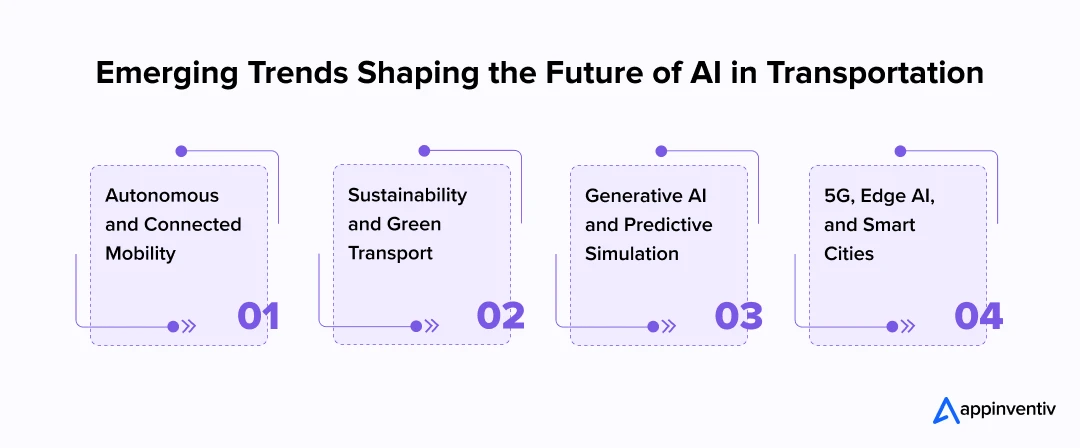
Autonomous and Connected Mobility
Self-driving vehicles are moving from test tracks to busy roads. The next step is deeper connection, where vehicles share data with signals, sensors, and other vehicles to prevent delays and accidents. For freight and delivery, this means faster routes, fewer breakdowns, and smoother coordination.
Sustainability and Green Transport
AI for transportation systems is helping businesses balance efficiency with environmental goals. AI-based transportation software now predicts energy use, manages EV charging, and plans cleaner routes. Over time, these small optimizations cut costs and lower emissions across entire fleets.
Generative AI and Predictive Simulation
Instead of reacting after problems occur, AI in transportation software development will soon predict them. Generative AI can simulate traffic, weather, or demand shifts to help teams plan better. It’s like having a digital twin of your operation that spots trouble before it happens.
5G, Edge AI, and Smart Cities
With 5G and edge computing, decisions can happen right on the vehicle, not miles away in a data center. This makes responses instant and safer for connected mobility. Together with IoT, it’s laying the groundwork for smart cities where parking, energy, and transport all run on shared intelligence.
Build Your AI-Based Transportation Software with Appinventiv
AI is transforming how transportation works, from smarter logistics and connected fleets to real-time decision systems that keep operations running smoothly. But turning those possibilities into real business outcomes takes more than technology; it takes experience, precision, and a deep understanding of how transport ecosystems function. That’s where Appinventiv comes in.
As a custom AI transportation software development company, we design custom platforms built around AI in transportation management, helping enterprises run safer, faster, and more cost-efficient operations. Our team combines domain knowledge in logistics, mobility, and fleet management with advanced AI engineering to create transportation platforms that are both powerful and practical.
Our approach focuses on solving business challenges first and layering AI where it creates real impact. Whether you’re building predictive maintenance software, AI chatbots in transportation for customer support, route optimization systems, or complete management platforms, we align every solution with your operational goals. Every project is built to scale, integrate with existing systems, and stay compliant with global standards in data privacy and safety.
By partnering with Appinventiv, you gain access to over 1500 technology specialists, including data scientists, AI strategists, machine learning engineers, and product architects, who bring hands-on experience in creating transportation and logistics systems that perform in real-world conditions. From initial planning to model integration and post-launch monitoring, our AI development services will help you every step of the way.
We don’t just build AI software; we build transportation systems that evolve with your business. Each implementation follows a compliance-first approach, protecting your data while maintaining accuracy and accountability across every process.
For instance, we worked with Americana Group, one of the region’s largest delivery networks, to create an AI-driven last-mile platform that optimized dispatching, tracked fleets in real time, and reduced delivery delays by automating routing decisions. The result was a faster, more reliable operation built on intelligent automation.
If your organization is ready to move from concept to large-scale transformation, connect with our AI experts today. Let’s build transportation software that’s not only intelligent but built to last, designed for speed, sustainability, and long-term business growth.
FAQs
Q. How to develop AI-powered transportation software?
A. Start with one problem. That’s it. Most companies pick something straightforward like cutting fuel waste or getting deliveries right and work from there. Once you’ve got your target, the rest falls into place:
- Pull together solid data from GPS trackers, sensors, old trip logs.
- Run machine learning, predictive analytics, and computer vision on it to find what’s hiding in the numbers.
- Build a rough MVP of your AI-powered transportation software. Test it with one fleet, maybe one city.
- Look at what worked, fix what didn’t, then go bigger when the numbers back it up. That’s how AI in transportation software development actually happens. Small steps, constant fixes, real proof before you expand.
Q. How to make transportation systems better using machine learning, predictive analytics, and computer vision?
A. They each handle different pieces. Machine learning tracks vehicle behavior where time bleeds out and where fuel gets burned for no reason. Predictive analytics tries figuring out what happens next, like when traffic’s about to pile up or an engine’s close to giving out. Computer vision? That’s your visual layer. It reads signs, watches for pedestrians, and follows lane markers. Combine them in AI transportation systems and routes start adapting on their own, fleets stay efficient without constant babysitting, and trips run cleaner end to end.
Q. What are the advantages of integrating AI into transportation systems?
A. You see changes fast once data flows in. Real-time tracking means you know exactly where vehicles are. Predictive insights let you fix things before they break down. AI transportation systems reroute themselves when weather turns bad or traffic gets messy. Eventually you’re dealing with less downtime, smaller fuel bills, better use of the assets you’ve already paid for. It’s not magic, just smarter control with better info.
- Real-time visibility across fleets and routes.
- Predictive maintenance that saves time and cost.
- Automatic route optimization for better efficiency.
- Improved safety through continuous monitoring.
Q. How does AI help with predictive maintenance in transportation?
A. Predictive maintenance sits in the background watching for trouble. AI reads signals from sensors like temperature shifts, tire pressure changes, weird vibrations and matches them against old records. Something looks strange? It throws up a warning. Your team gets ahead of repairs instead of scrambling when a vehicle dies mid-route. For fleets with hundreds of vehicles, that early notice keeps everything rolling, slashes repair costs, dodges emergency breakdowns.
Q. What is an example of how AI is used in transportation engineering?
A. Cities test changes before they build anything permanent. Traffic data from cameras and sensors gets fed into models to see if new signal timing or lane configurations would help. Engineers also stick AI-powered sensors on bridges to catch cracks, stress points, and corrosion early. Maintenance gets scheduled before something collapses. Simple stuff, but that’s AI in transportation engineering keeping cities safer and infrastructure standing longer.
Q. What is the cost of AI transportation software development?
A. Depends what you’re after. A basic pilot- fleet tracking, maybe route optimization- runs somewhere between $40,000 and $90,000. Full AI transportation management platform with predictive analytics, automation, the works? You’re looking at $250,000, possibly more. Big cost drivers are data collection, connecting to your existing systems, how much custom work you need. A dedicated AI app development company like Appinventiv keeps budgets honest and helps you scale without blowing money upfront.
Q. How long does it take to build an AI transportation system?
A. Depends how big you’re going. Small MVP? About three months to build and test properly. Full AI-based transportation app development with integrations, automation, analytics running across everything? Six months minimum, often longer. Goes quicker if your data’s already clean and you know exactly what you want. Working with people who’ve done AI in transportation software development before means fewer false starts and wasted budget.
Q. How to measure ROI from AI in transportation systems?
A. ROI builds over time, not overnight. Companies watch delivery speeds, how much vehicles sit idle, how often maintenance hits. AI in transportation engineering helps businesses trim wasted hours, keep fleets moving, and bring operating costs down. Those wins compound. Eventually they show up in customer feedback, how efficiently you’re using resources, and bottom line numbers.
- Reduced fuel and maintenance expenses.
- Faster route planning and fewer delays.
- Improved fleet uptime and driver safety.
- Steady cost savings that grow every year.
Q. What is the potential of generative AI in the transportation and logistics sector?
A. Generative AI in the transportation and logistics space isn’t replacing anyone- it’s giving people a way to see what’s coming. It builds virtual copies of real networks so you can test routes, traffic flow, delivery windows before trucks actually roll. Teams spot trouble early, weather that’ll mess things up, fuel running low, and work around it instead of fixing disasters on the fly. It can sketch out better warehouse layouts or tweak schedules when a truck dies or orders jump unexpectedly.
Think of it like a problem-solver that gets smarter the more it runs, cutting waste, tightening timelines, making the whole system work better bit by bit.


- In just 2 mins you will get a response
- Your idea is 100% protected by our Non Disclosure Agreement.
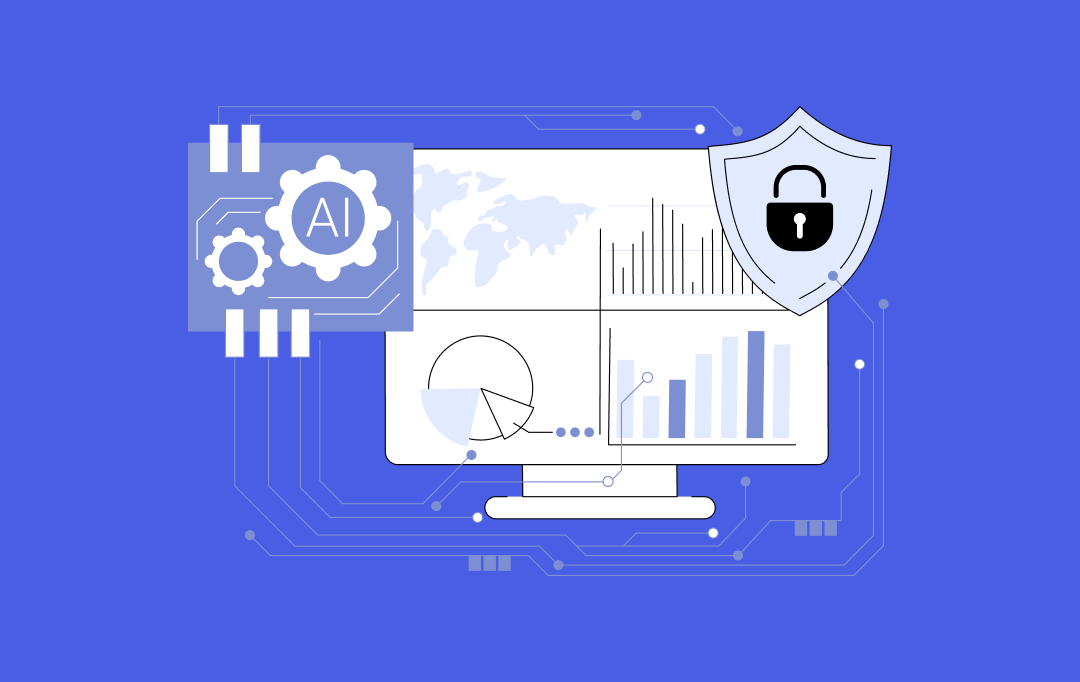
AI Governance Consulting: How to Build Guardrails, Observability, and Responsible AI Pipelines
Key takeaways: Enterprises can no longer rely on principles alone; AI governance must be built into pipelines, model workflows, and decision systems from day one. Strong guardrails across training, inference, retrieval, and agentic actions reduce risks like hallucinations, data leakage, and prompt injection. AI observability is central to governance, giving leaders real-time visibility into drift,…
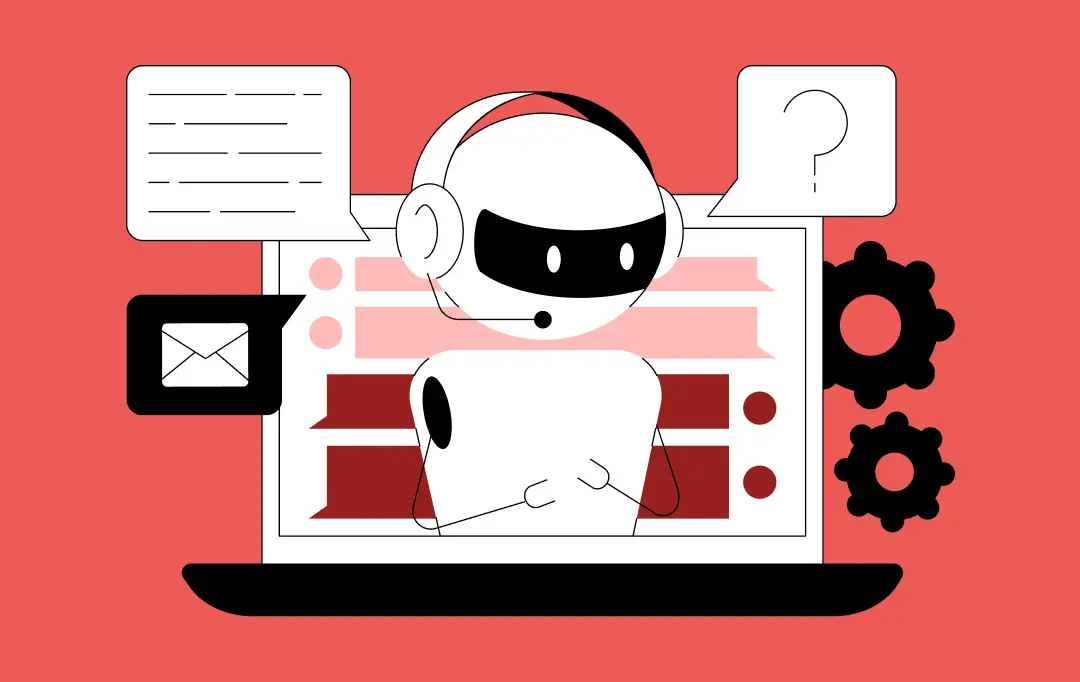
How to Build a Custom Multilingual Chatbot? Features, Process, Costs
Key takeaways: Multilingual Chatbots Drive Revenue Growth: Companies see higher conversion rates when customers can interact in their native language, with nearly 75% of global customers preferring to buy from websites in their preferred language. Beyond Translation to Cultural Intelligence: Successful implementations require cultural adaptation, not just language translation. Systems must understand context, emotion, and…

How Much Does It Cost to Build an AI App in Dubai?
Key takeaways: AI app costs in Dubai typically range from AED 80,000 for simple builds to AED 800,000+ for enterprise systems. Dubai is past AI experimentation, and not investing now means catching up later at higher cost. The real budget is driven by data, integrations, architecture, and compliance, not just app features. Hidden costs like…











